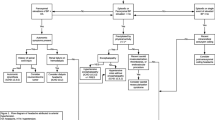Abstract
Migraine is a neurovascular disorder characterized by autonomic nervous system dysfunction and severe headache attacks. Studies have shown that changes in the intracranial vessels during migraine have an important role in the pathophysiology. Many studies have been conducted on the increased risk of stroke in patients with migraine, but insufficient data are available on the mechanism underlying the increase. This study aimed to evaluate basal cerebral blood flow velocity and vasomotor reactivity in patients with chronic migraine. We evaluated 38 patients with chronic migraine. Three of them were excluded because they had auras and four of them were excluded because of their use of medication that can affect cerebral blood flow velocity and breath holding index (beta or calcium channel blockers). Our study population consisted of 31 patients with chronic migraine without aura and 29 age- and gender-matched healthy individuals who were not taking any medication. The mean blood flow velocity and breath holding index were measured on both sides from the middle cerebral artery and posterior cerebral artery, with temporal window insonation. The breath holding index for middle cerebral artery and posterior cerebral artery was significantly lower in the migraine group compared to that of the control group (p < 0.05).The vasomotor reactivity indicates the dilatation potential of a vessel, and it is closely related to autoregulation. According to our results, the vasodilator response of cerebral arterioles to hypercapnia was lower in patients with chronic migraine. These findings showed the existence of impairments in the harmonic cerebral hemodynamic mechanisms in patients with chronic migraine. This finding also supports the existing idea of an increased risk of stroke in patients with chronic migraine due to impaired vasomotor reactivity.
Similar content being viewed by others
References
Dib M (2008) Optimizing prophylactic treatment of migraine: subtypes and patient matching. Ther Clin Risk Manag 4(5):1061–1078
Moghaddasi M, Sina F, Haghi-Ashtiani B, Rohani M, Zamani B (2008) Cerebral hypercapnia-induced vasomotor reactivity in migraine with and without aura: a case-control study. MJIRI 21(4):203–208
Dora B (2005) Migren ve diğer primer başağrılarında vazomotor reaktivite. J Turk Cerebrovasc Dis 11(3):91–99
Uzuner N (2004) Fonksiyonel Transkraniyal Doppler ve Migren Baş Ağrısı. Türk Nöroloji Dergisi 10(4):263–272
Daffertshofer M, Hennerici M (1995) Cerebrovascular regulation and vasoneuronal coupling. J Clin Ultrasound 23:125–138
Tekgöl Uzuner G, Çınar N, Uzuner (2009) The blood flow velocity changes to simple and complex visual stimulation at posterior cerebral arteries. J Turk Cerebrovasc Dis 15(2):43–46
Headache Classification Committee of the International Headache Society (IHS) (2013) The international classification of headache disorders, 3rd edition (beta version). Cephalalgia 33(9):629–808
Stang PE, Stemfield B, Sydney S (1996) Migraine headache in a prepaid health plan: ascertainment, demographics, physiological and behavioral factors. Headache 36:69–76
Silberstein SD, Lipton RB, Goadsby PJ (1998) Headache in clinical practice. Isis Medical Media, 1–7
Dora B (2005) Migren ve diğer primer başağrılarında vazomotor reaktivite. J Turk Cerebrovasc Dis 11(3):91–96
Silvestrini M, Matteis M, Troisi E, Cupini LM, Bernardi G (1996) Cerebrovascular reactivity in migraine with and without aura. Headache 36(1):37–40
Zwetsloot CP, Caekebeke JF, Ferrari MD (1993) Lack of asymmetry of middle cerebral artery blood velocity in unilateral migraine. Stroke 24(9):1335–1338
Harer C, vevon Kummer R (1991) Cerebrovascular CO2 reactivity in migraine: assessment by transcranial Doppler ultrasound. J Neurol 238(1):23–26
Silvestrini M, Baruffaldi R, Bartolini M, Vernieri F, Lanciotti C et al (2004) Basilar and middle cerebral artery reactivity in patients with migraine. Headache 44(1):29–34
Fiermonte G, Pierelli F, Pauri F, Cosentino FI, Soccorsi R et al (1995) Cerebrovascular CO2 reactivity in migraine with aura and without aura. A transcranial Doppler study. Acta Neurol Scand 92(2):166–169
Thie A, Fuhlendorf A, Spitzer K, Kunze K (1990) Transcranial Doppler evaluation of common and classic migraine. Part I. ultrasonic features during the headache-free period. Headache 30(4):201–208
Thomsen LL, Iversen HK, Olesen J (1995) Increased cerebrovascular pCO2 reactivity in migraine with aura—a transcranial Doppler study during hyperventilation. Cephalalgia 15(3):211–215
Rieke K, Gallen CC, Baker L, Dalessio DJ, Schwartz BJ et al (1993) Transcranial Doppler ultrasound and magnetoencephalography in migraine. J Neuroimaging 3(2):109–114
Totaro R, Marini C, De Matteis G, Di Napoli M, Carolei A (1997) Cerebrovascular reactivity in migraine during headache-free intervals. Cephalalgia 17(3):191–194
Kitazono T, Faraci FM, Taguchi H, Heistad DD (1995) Role of potassium channels in cerebral blood vessels. Stroke 26:1713–1723
Nelson MT, Quayle JM (1995) Physiological roles and properties of potassium channels in arterial smooth muscle. Am J Physiol Cell Physiol 268:799–822
Molina C, Sabin JA, Montaner J, Rovira A, Abilleira S, Codina A (1999) Impaired cerebrovascular reactivity as a risk marker for first-ever lacunar infarction: a case-control study. Stroke 30:2296–2301
Markus H, Cullinane M (2001) Severely impaired cerebrovascular reactivity predicts stroke and TIA risk in patients with carotid artery stenosis and occlusion. Brain 124:457–467
Conflict of interest
The authors declare that they have no conflict of interest.
Author information
Authors and Affiliations
Corresponding author
Rights and permissions
About this article
Cite this article
Akgün, H., Taşdemir, S., Ulaş, Ü.H. et al. Reduced breath holding index in patients with chronic migraine. Acta Neurol Belg 115, 323–327 (2015). https://doi.org/10.1007/s13760-014-0375-y
Received:
Accepted:
Published:
Issue Date:
DOI: https://doi.org/10.1007/s13760-014-0375-y




